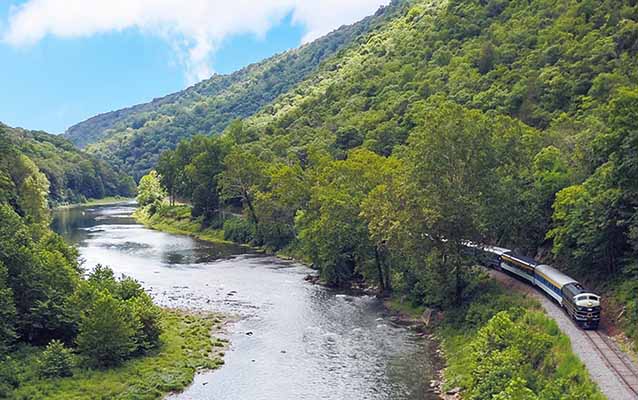Last updated: August 4, 2022
Place
Appalachian Forest National Heritage Area

Photo courtesy Potomac Eagle Scenic Railroad/Dream Cut Films
Scenic View/Photo Spot
The Appalachian Forest National Heritage Area (AFNHA) works to conserve, enhance, interpret, and promote a regional network of forest heritage resources in the central Appalachian Highlands. Designated a National Heritage Area in 2019, AFNHA covers sixteen counties in West Virginia (Barbour, Braxton, Grant, Greenbrier, Hampshire, Hardy, Mineral, Morgan, Nicholas, Pendleton, Preston, Pocahontas, Randolph, Tucker, Upshur, Webster) and two counties in western Maryland (Garrett, Allegany).
Forest heritage is the ongoing story how the forest shapes history and culture, and how both nature and humans shape the forest. The mountains and forests have played a central role in central Appalachian life since the first indigenous inhabitants, and the landscape continues to cultivate local traditions, folkways, language, crafts, dance, music, festivals, and fairs. Logging after the Civil War fueled the industrial revolution and provided an important livelihood for workers, but the demand for timber decimated the forests. Today, scientific forestry and public land holdings have allowed the forests to regrow, providing sustainable forest products while offering an abundance of outdoor recreational opportunities, including hiking, biking, fishing, hunting, camping, climbing, and skiing. The history of the region is represented by its plentiful historical societies, museums, and historic preservation efforts. Forest communities and main streets offer a variety of small town experiences, with arts, shopping, local foods, and a hearty welcome for visitors.
AFNHA is managed by the grassroots nonprofit Appalachian Forest Heritage Area, Inc. (AFHA). AFHA partners with organizations with shared goals and is developing a management plan to coordinate partnership efforts to conserve the area’s forests and strengthen rural communities through conservation, historic preservation, education, heritage tourism, and sustainable economic development.
Notable points of interest in the region include:
- Appalachian Forest Discovery Center
- Canaan Valley National Wildlife Refuge
- Chesapeake & Ohio Canal National Historical Park
- Monongahela National Forest
- Potomac Heritage National Scenic Trail
- Excursion trains, such as the Cass Scenic Railroad
- Historical societies and small museums
- State parks and state forests
- Welcoming rural communities
